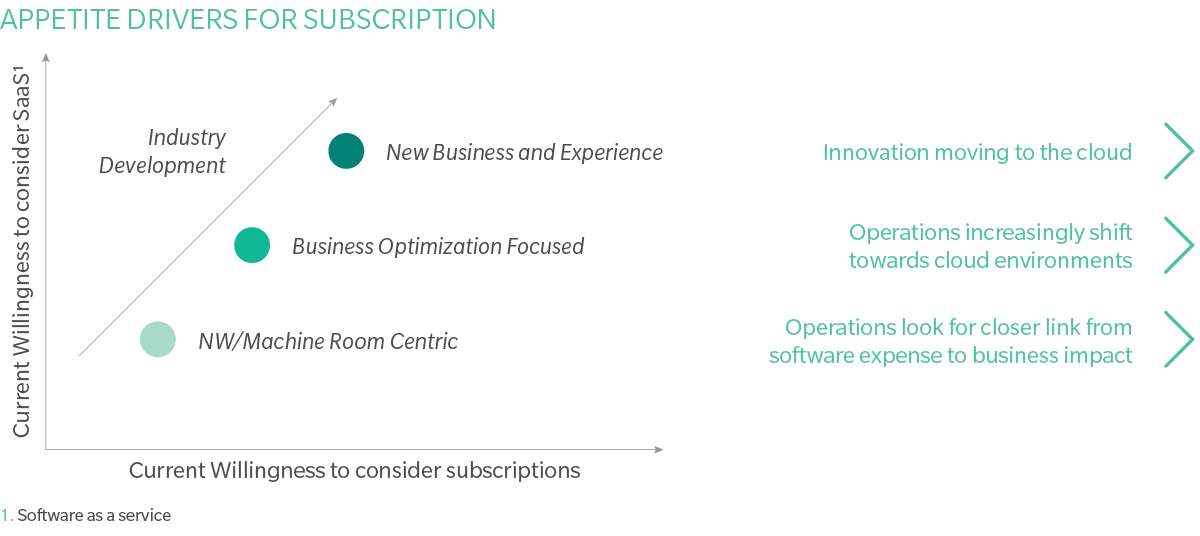One implication is an increase in telecom operators’ IT spending. We expect it to rise by around 5 percent a year for enterprise IT and nearly 10 percent a year for software. More importantly, operators are reconsidering the way they purchase software. Traditionally, they have bought licenses to use software for perpetuity, but this model has drawbacks. It makes the telecom operator less agile, while updates have to be implemented and paid for, so costs do not actually finish with the one-off purchase.
We think telecom operators will increasingly move towards a subscription model for obtaining software. The developers of the latest software innovations tend to offer their products only on a subscription basis. In addition, operators are increasingly looking for risk-sharing arrangements that link their IT spending with the revenues that result, so that they pay just for the software they use. For vendors, this can be an opportunity to benefit from additional revenues the telecom operator achieves.
In contrast to other industries, however, the perpetuity model will not disappear from telecoms for at least the next five years, but will remain viable in parts of the market. Managing this shift will have a major impact on the efficiency of telecom operators’ organizations and the attractiveness of their services to consumers. To cast some light on the complexity of software sales and pricing, we spoke with about 25 senior industry executives from both operators and vendors. This paper summarizes the results.
APPLIED SOFTWARE BUSINESS MODELS
Our research revealed two major dimensions in software procurement. One is the type of transaction. Telecom operators can either develop their own software, buy it for perpetuity, or subscribe to it through periodic payments. The other dimension is the power balance between buyer and seller: A software vendor might have more power if its product is a disruptive one that telecom operators decide is essential; but an operator will have more power if it has a wider choice of vendors.
Influenced by these forces, seven archetypes for telecom software purchase have emerged, which were confirmed by our series of interviews. In each archetype, vendors and operators leverage their negotiating powers in a different manner. Typically, the party with the greater negotiating power is able to impose its preferred model.
The buyer concentration typically found in this market might be expected to favor the telecom operator in negotiations. However, evidence is mounting that leading software-as-a-service (SaaS) players often have sufficient leverage to impose their preferred model, especially when their product is used in a variety of industries – such as insurance and healthcare, in addition to telecom. That’s usually because either they are clear leaders in their domains, or they are startups on the brink of rapid growth with a unique offering
Exhibit 1: Map of telecom software deal archetypes

Source: Oliver Wyman analysis
1. THE MAKE-IT-YOURSELF MODEL
An ever-more attractive alternative is for the operator to develop and operate software on its own. Nonetheless, it remains to be seen how most operators would cope with the stringent requirements of the software lifecycle – the efforts needed for development, maintenance, and debugging.
1.1. Open Source
Some telecom operators have created opensource-based software platforms and plan to publicize these offers. At least one collaborative project has had some success with software for base stations.
1.2 Ramp-Up Of Capabilities And In-House Development
This has become the dominant model for the Internet giants. However, telecom operators have largely avoided this model up to now, due to a shortage of the skills and know-how required to develop and manage software over its lifecycle.
2. THE PERPETUITY MODEL
Perpetual licenses are the traditional model for purchasing software. The buyer pays for the software license up-front and has the right to use it indefinitely – or at least as long as it is supported by the vendor and no major release upgrade is required. On top of the license fee, one-off implementation services and an annually renewed support contract typically form part of the transaction.
2.1. Vendor Pushes As Part Of Capex Bundle
This archetype is typical for procurements related to large networks where the commercial logic is driven by the vendor. From a vendor’s point of view, the perpetuity model offers a faster route to cash and predictable income.
2.2 Buyer Prefers Perpetuity
For a telecom operator, the perpetuity model involves a one-off purchase cost, making for simple management when there is little change in software needs. There is no need to share profits or any other upside with the software vendor. And the operator can re-assign the license internally, for example between different companies it runs in different countries. Moreover, the operator may be able to negotiate a discount by bundling the software with a larger procurement package.
These factors make the perpetuity model particularly suitable for buyers that want their software costs to be transparent and predictable. For instance, if an operator’s business is stable and it is confident of future revenue flows, then it might prefer the clarity of an upfront payment and not have to worry about its consequences for profitability.
Perpetual licenses have been the model of choice for a long time. But there are drawbacks, in particular related to speed. New versions of the software have a long lead time and require significant effort to integrate. A version of the software has to stay in use for a relatively long time after its release. If the operator wants updates and upgrades, these typically require heavy customization.
3. THE SUBSCRIPTION MODEL
Under subscription-based licensing, a telecom operator pays at regular intervals for access to a vendor’s IT services. The model is becoming increasingly popular, and the trend towards cloudification is expected to give it even more momentum. A majority of industry experts hypothesize that subscription will become the dominant commercial model, even for telco software. “We already see a clear acceleration towards subscriptions via software as a service,” said one procurement expert at a leading operator group.
Subscription has been the model of choice for telecoms operators for a long time when it comes to monetization of their own services. But they have mainly procured hardware, systems, and services from their suppliers as capital expenditure – one reason being that EBITDA has been the prime metric for comparison in the industry.
However, top-line growth is slowing. As a result, over-the-top services, mobile virtual network operators, and device manufacturers are attacking with new business models. In subscription services, operators pay only for what they use, avoiding huge upfront investments and being able to adjust their expenditure better to their revenues and business outcomes.
In addition, subscription fosters a relationship between vendor and operator that leads to better products and more effective use of them. Vendors have an incentive to get systems up and running quickly and to continuously improve their experience and functionality. These enhancements can then fuel further adoption by telecom operators, igniting a virtuous cycle that benefits both parties. “Alignment of commercial interests is key,” said the CTO of a large operator in Asia. “We want our vendors to have skin in the game, by linking their payout to our success. This is win-win.”
It is especially important to measure the costs and contributions of software as mobile phones move from the current SIM paradigm to the next generation of technology. “Predictability is a key factor, and it is critical to find the right metrics” for subscription pricing,” said one CIO. “Using a SIM-based model in an IoT-centric world is probably not a good idea."
Exhibit 2: Cycle of benefits of subscription-based software model

Source: Oliver Wyman analysis
New business models make accountability more complex, as mutual trust between operator and vendor is vital for the parties to accept them. At the same time, operators must also find the right metrics to measure success. “If the vendor proposes a new subscription-based model with a complex compensation scheme, the alarm bells go off,” said the CTO of a European group. “This is typically more advantageous for the vendor.”
Some software product segments are more prone than others to migrate to subscription, so there will be differences in speed. However, both vendors and operators are likely to be pushed towards it.
Telecom operators can be driven towards the subscription model by the lower entry barrier and upfront costs, as well as the ease with which they can try new features. Because costs are transparent and the operator pays only what it uses, there is no risk of over-provisioning. Spending on the software and generated benefits are better aligned – an arrangement which fits innovative growth businesses with uncertain outcomes and that is more affordable for smaller or cash-constrained operators. Moreover, greater customer feedback leads to faster evolution of features and usability.
For software vendors, subscription can stabilize their revenue streams, so they are not driven to measures such as end-of-quarter fire sales. They can diversify their installed bases and gain access to customers of different sizes in different places. The subscription relationship makes it easier to establish an ongoing dialogue with customers, letting them be proactive about the industry’s future direction and providing opportunities for monetizing their products through continuous cross- and up-selling. In addition, the model is easy to scale and aligns well with cloud-based delivery.
Overall, the parties are incentivized towards a win-win strategy focused clearly on customer success. “I am convinced that in telco everything will converge to a subscription model,” one telecoms executive said. “It might be a slower transition than in other industries because of legacy factors, but there is no question about the end game.” The three subscription archetypes vary according to which partner is dominant.
3.1. Vendor Dominates With Disruptive Product:
In some situations, the software vendor’s product is more than a commodity, and its features and functionality are almost unique. This kind of differentiation is not limited to big or well-established players. An increasing number of smaller players are confidently offering only one commercial model on a take-it-or-leave-it basis to limit complexity and ensure scalability with a cloud-based delivery model. “If the features are unique, the software vendor has the upper hand and can dictate the commercial model,” said one telecom CTO. “This is typically subscription-based and comes with a higher total cost of ownership. But you don’t have a real alternative.”
3.2 Feature-Based Win With Custom Commercial Model
In this case, operators and vendors have a mutual interest in a long-term innovation partnership and are willing to agree on a joint metric for sharing success. One ingredient for success is parity in negotiating power. Another is the alignment of the operator’s success and the vendor’s propensity to add new, attractive features. As such, subscription models already prevail where the focus is on business growth. Their popularity is increasing because they tend to lead to win-win outcomes. “We co-innovate by agreeing a joint roadmap and regular reviews,” said a telco executive. “A subscription model facilitates this more easily and more directly. Everybody is focused on rapid success."
3.3 Buyer Forces Cloud Solution As Part Of Default Architecture:
As the total number of telco operators is limited, they typically have strong leverage over vendors and can, in many cases, force them to adopt their preferred business model. Operators are increasingly moving their production environment to the cloud, and vendors must comply. Consequently, an on-premise perpetuity model will not work. Simply put, this constitutes the re-emergence of the classic power relationship under a new commercial model.
Much to vendors’ dislike, operators sometimes leverage their power in the case of unpredictable, highly innovative categories of software. If operators are big and the business potential of some software is uncertain, they can demand a success-based subscription model, effectively outsourcing the risk to cloud players that are typically young and emerging.
IMPLICATIONS
Based on the insights and data gathered for this study, we foresee a fluid transformation towards software subscription in telecoms as in other industries before. (See Figure 3.) However, many telecom operators continue to buy software bundled with other technology on a perpetuity basis, so the perpetuity model is expected to prevail in some areas of the business. A major reason that the transformation is accelerating is the increasing number of small players. Many build their solutions entirely in the cloud and offer their products on a subscription-only basis. Secondly, operators are moving their production environments into the cloud, so they need cloudready solutions from vendors. Thirdly, operators are increasingly looking for ways to link their spending to business results, which also favors subscription models. “Our capex is now strongly aligned with user and revenue development,” said one telco CTO. “Vendors are participating in the upside.”
Exhibit 3: Appetite drivers for subscription

Source: Oliver Wyman analysis
IMPLICATIONS FOR TELECOM OPERATORS
Telecom operators need to build the capabilities to engage with next-generation vendors. That implies opening up and modularizing their IT architecture in such a way that they can combine legacy systems and either host or connect to cloud-based solutions. On the commercial side of their business, operators have to understand solution economics and risks so that they can make well-informed trade-offs between the different software procurement models.
Currently, there are few similarities between the IT at typical telecom operators and that at leading digital players. However, software has become a critical, differentiating part of all industrial companies’ products. So telecom operators need to align their software architecture to that of digital leaders.
IMPLICATIONS FOR VENDORS
In some parts of the telecom software market, operators will want to buy software on a perpetual basis and will have the power to demand this. So software vendors will need a resilient goto-market approach that can respond flexibly to both the perpetual and subscription pricing models. (See Figure 4.) If a portfolio is not ready for the subscription model or for cloud delivery, the vendor will have to make a major effort involving a multitude of activities that include the following:
Go-To-Market Strategy: The vendor will need a way to measure and understand customers‘ use of applications and features. It will also need to establish a closed loop in which usage insights can be shared and innovation directed towards a maximization of customer success. A modular architecture based on microservices and with fast release cycles will have to be implemented.
Sales And Commercial Model: A new, overarching commercial model will be required. In particular, the sales force will have to acquire new skills so that they evolve into client success managers who work to help clients make the most out of the software they are using. This implies changes to the way sales staff report and their compensation schemes.
Solution Architecture: The vendor’s solution architecture needs to be ready for deployment in various schemes, both on and off-premise. It must be able to produce commercially viable, transparent utilization metrics.
Moving to a subscription model implies a short-term dip in revenues. One way to cope with this is workarounds, such as enterprise license agreements. However, it will also be necessary to communicate the changes to vendors’ investors. If this is done well, all stakeholders will understand the changes and their impact on the top and bottom lines.
SUBSCRIPTION-BASED BUSINESS MODELS ON THE BRINK OF SUCCESS
Over the last few years, the software industry has been moving away from a perpetuity-based business model and towards subscriptions. This movement has been driven by the ongoing cloudification of software and its use as a service (“aaS”) – first in customer-facing businesses (B2C) and swiftly followed by business-to-business (B2B) activities.
But this shift has not been completed in all industries. Telecom operators in particular are still undecided about how to walk this path in open-source software (OSS) and business support systems (BSS). The change will come first in software that delivers customer-facing functionalities and in use cases that carry a relatively high risk. Software related to networks will follow. New BSS and OSS vendors will accelerate the change, as will startups with more-innovative cloud offerings.
These moves will push established vendors and operators to rethink their commercial models and their models for delivery or procurement. Many telecom operators, especially large ones, are still dependent on archaic systems that are 20 years old or more. It is time for them to transform their system landscapes.






